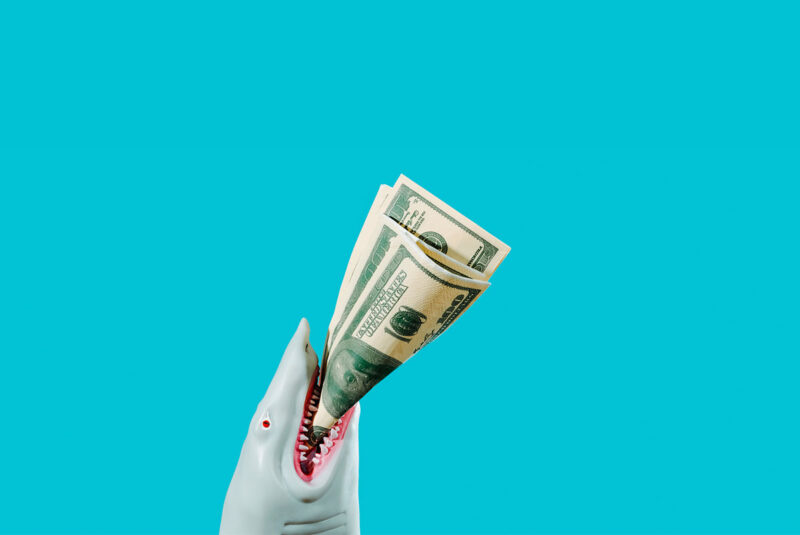When we think of predatory lending, some of us might imagine the stereotypical loan shark. You know, the slightly menacing lender who lends money at ruinous interest rates and threatens to send someone to break a beloved appendage if we don’t pay on time.
The truth is, predatory lending is more common than many borrowers realize. Predatory lending or alternative financial services can take many forms, and it isn’t always easy to tell the difference between predatory lenders and legitimate lending institutions.
Understanding how predatory lending works, the warning signs of predatory lending and how to avoid it can help you to protect yourself.
61%
of alternative financial services users have an annual household income under $40,000.[1]
Predatory Lending Defined
Predatory lending is any abusive or deceptive lending practice used by a financial institution that:
- Imposes unfair or abusive loan terms: This includes charging higher interest rates and fees compared to reputable lenders. Abusive loan terms may heap more debt on borrowers, forcing them to borrow more and trapping them in an unending debt spiral.
- Strips borrowers of equity: Standard mortgage and auto loans use a valuable asset, like your home or car, as collateral. Reputable lenders will only repossess an asset as a last resort. Predatory lenders will often put a borrower in a position to lose their asset in a short period of time.
- Uses aggressive sales tactics and deception: Every lender wants you to borrow from them, but predatory lenders use manipulative sales tactics and misleading contracts to convince borrowers to take out loans they can’t afford.
- Targets vulnerable populations: Predatory lenders tend to target communities of color, non-English speakers, older adults and other vulnerable groups, knowing these borrowers may not have other options or may not fully understand what they’re signing. They also know these populations are less likely to contact the authorities.
Examples of Predatory Lending
To help you understand what types of predatory lending exist, here are examples of predatory loans and predatory lending practices:
Types of predatory loans
While some aspects of predatory lending are illegal, predatory lending is often legal, despite high interest rates and abusive practices.
Subprime mortgages
Initially, subprime mortgages were intended to help home buyers who couldn’t qualify for conventional mortgages. But predatory lending practices in the subprime loan market by mortgage lenders and large financial institutions were one of the driving forces of the 2008 financial crisis. The crisis led to reforms in the mortgage industry and the creation of the Consumer Financial Protection Bureau (CFPB).
Lenders still offer subprime loans, but they are subject to stricter oversight. There are also alternative options available for buyers who may have trouble saving for a down payment.
Payday loans
Payday loans are short-term, small-dollar loans that charge high interest rates and fees. Every state has regulations regarding payday lenders.
Asset-based lending
With asset-based lending, a lender offers you a loan based on the value of your collateral (like a home or car), not your ability to repay the loan. If you miss payments, the lender will take immediate possession of the asset.
Car title loans
Car title loans are a type of asset-based lending. They are short-term loans that let you borrow against the value of your car. The loans usually last 14 – 30 days and often charge between 10% and 30% interest.[2] If you take out an auto title loan for $1,000 at 20% interest, you’ll owe the lender $1,200 at the end of the loan term. Miss a monthly payment, and the lender can take your car.
Predatory lending practices
Here are some of the most common tactics predatory lenders use to take advantage of borrowers:
Inadequate or false disclosure
Predatory lenders don’t spell out all the terms and conditions of a loan. They either bury the conditions in fine print or force the borrower to meet vague or unreasonable terms.
Inflated fees
The extra fees charged by predatory lenders are higher than the fees charged by reputable lenders. They also tend to be buried in the fine print.
Loan flipping
This happens when a lender pressures you to refinance your loan over and over again. Every time you refinance, your lender collects more money in fees. And your debt usually climbs because with each refinance you extend the life of your loan, increasing how much you pay in interest over time.
Balloon payment
With balloon payment loans, borrowers make low monthly payments for a set time and then make one substantial payment at the end of the loan. While this payment structure can work in some scenarios, including some real estate investments, many borrowers are often misled into believing the loan is more affordable than it is, leaving them unable to pay off the loan when the balloon payment is due.
Unnecessary add-on products or services
Lenders may add services or pressure you into buying optional extras like unnecessary insurance plans.
Reverse redlining
Redlining was a race-based, federal government housing policy that denied home buyers of color, particularly Black home buyers, mortgages in predominantly white communities. The illegal practice was outlawed in 1968, but many redlined communities are largely made up of lower-income Black and Latinx homeowners, making them prime targets for reverse redlining, with predatory lenders offering credit in those communities on unfair terms.
Negative amortization
Typically, loan payments are amortized, which means they’re structured so your loan balance goes down over time. The monthly payments on a negatively amortizing loan aren’t large enough to cover the monthly cost of the loan. When that happens, the size of the loan increases over time, and borrowers wind up owing more.
Warning Signs of Predatory Lending
Using the “if it looks too good to be true, it probably is” test to figure out if a lender is untrustworthy is one way to protect yourself, but the truth is more complicated. Trust your gut, of course, but look out for these warning signs of predatory lending:
- Abnormally high three-digit interest rates: Most loans and credit cards have an annual percentage rate (APR) cap of 36%.[3] If a loan has a higher APR, it’s probably a predatory loan. Keep in mind, while payday loans may offer an interest rate of 25%, that’s a monthly rate. If you converted the monthly interest rate into an APR, it would be more like 400%.[4]
- Lack of transparency about APR and cost: The Truth in Lending Act requires lenders to give borrowers information about interest rates, fees and other information in clear, standardized terms. If a lender doesn’t do this, it may mean they’re hiding something.
- No credit check: Legitimate lenders will typically require a hard pull of your credit report to approve a new credit application. If a lender doesn’t check your credit, it may mean they’re more interested in your collateral than your ability to repay a loan.
- Your only payment option is automatic withdrawal: Autopay can be a convenient way to pay your bills. If a lender only accepts payments by automatic withdrawal, it may be a sign that they’ll withdraw money even when you don’t have enough in your account.
- A history of customer complaints: Even the most ethical lender can receive the occasional complaint from an unsatisfied customer. But if a lender has an extensive history of customer complaints, that’s likely a red flag.
- Can’t build credit with on-time payments: One of the benefits of taking out a loan is having your on-time payments reported to the credit bureaus. Typically, predatory lenders will not report your on-time payments to the bureaus. If a lender doesn’t report your on-time payments, it makes it harder to build credit. In some cases, predatory lenders will only report if you miss a payment, which can damage your credit score.
How To Avoid Predatory Loans
Predatory lenders can be incredibly sophisticated and look a lot like legitimate lenders. To help avoid predatory lenders, take these steps before committing to any loan:
- Educate yourself: Before taking out any loan, make sure you know what you should expect from a traditional lender and what they are legally required to provide you with.
- Read everything: Carefully read through the loan agreement before you sign anything. If you have any questions, ask them and demand answers in terms you understand.
- Don’t rush: Many predatory loans, like payday loans, are attractive because you can get same-day cash – but that speed could cost you. Before you borrow, figure out how quickly you need the money. You may be able to find a better option that puts money in your hands quickly.
- Be willing to walk away: It’s human nature to want to see things through, honor a handshake agreement and respect people’s time. Predatory lenders are counting on that and know that we may not walk away out of fear of being seen as rude or untrustworthy. But if you discover a hidden fee or condition that worries you, don’t be afraid to walk away.
- Shop around: Predatory lenders like to position themselves as the only game in town. But it’s usually not true. Before committing to a lender, look for other lenders in your area or research online loans. You may be able to find a more reputable option.
- Consider alternatives: If you’re considering a predatory lender because of credit issues, there may be better alternatives. Talk to your local bank or credit union. They may be able to connect you with government-backed loans or loan programs for borrowers with credit issues. There are also bad credit personal lenders that offer high-interest but nonpredatory loans.
- Seek credit counseling: If you’re taking out high-interest loans to pay off your bills, it may be a sign that you’re struggling to control your debt. Talking to a credit counselor can help you better manage your debt, so you can avoid getting caught in a predatory lending spiral.
Don’t Fall for It
Predatory lending can come in many different forms – and financial literacy is the best defense you have. Knowing how predatory lending works, the signs of predatory lending and what better options are available, you can make smarter borrowing choices to protect your financial future.
The Short Version
- The common red flags of predatory lending are high interest rates, a lack of transparency and an application process with no credit check
- Predatory lending or alternative financial services can take many forms, and it isn’t always easy to tell the difference between predatory lenders and legitimate lending institutions
- While some aspects of predatory lending are illegal, predatory lending is often legal
Consumer Financial Protection Bureau. “Consumer use of payday, auto title, and pawn loans: Insights from the Making Ends Meet Survey.” Retrieved June 2022 from https://files.consumerfinance.gov/f/documents/cfpb_consumer-use-of-payday-auto_title-pawn_loans_research-brief_2021-05.pdf
Federal Trade Commission. “What To Know About Payday and Car Title Loans.” Retrieved June 2022 from https://consumer.ftc.gov/articles/what-know-about-payday-and-car-title-loans
National Consumer Law Center. “Why 36%? The History, Use, and Purpose of the 36% Interest Rate Cap.” Retrieved June 2022 from https://www.nclc.org/images/pdf/pr-reports/why36pct.pdf
NYS Department of Financial Services. “Dangerous or ‘Predatory’ Loans | Department of Financial Services.” Retrieved June 2022 from https://www.dfs.ny.gov/consumers/scams_schemes_frauds/dangerous_or_predatory_loans




